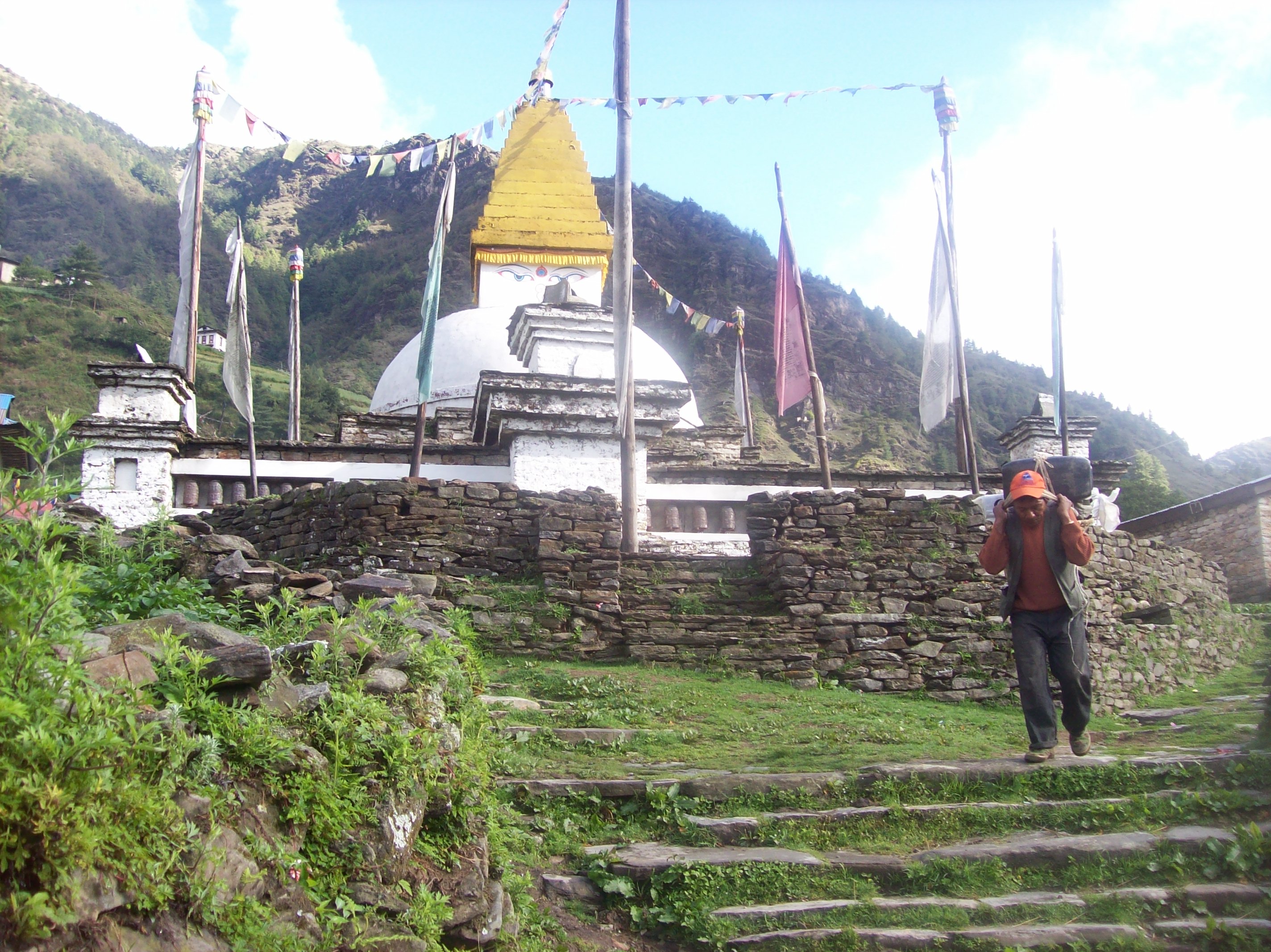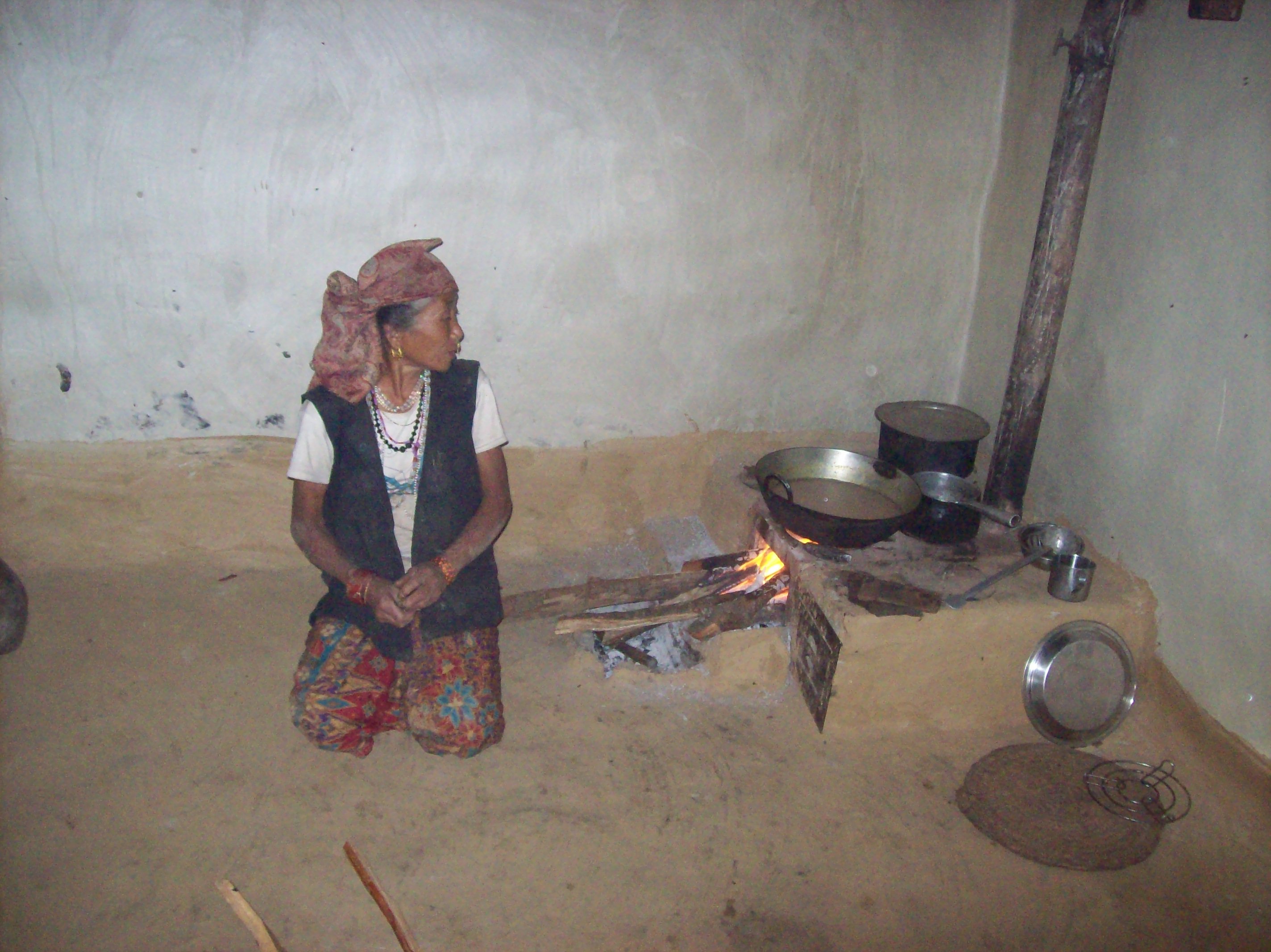Return to Home Page
Prior Expedition, Spring 2013 Pikey Peak - Basa Village; "Philanthro-trek"
of Marion University students and other friends of the Basa Village Foundation
(Jeff's photo album from the trek:
https://plus.google.com/photos/104731913652844816663/albums/5892086337689186593)

Our expedition was a challenging one from the start. The day before we were
to depart Katmandu two buildings adjacent to our hotel, the Katmandu Guest
House, burned down. (One was the well-known Pilgrim's Bookstore -- the only
retailer in Nepal to stock my book.) Some guests fled the KGH, but we
stayed and several in our group helped fight the fire. (Talk about a
Chinese fire drill -- you should see how a fire is fought in Katmandu!
There were lots of stones thrown at the burning buildings by excited young
men.)
The actual trek began propitiously for our group of 13 trekkers staffed
by Adventure GeoTreks with our
first meal on the trail served by our staff in the open air.
http://www.flickr.com/photos/quiltbinder/9052744971/in/set-72157634088258155
Beginning that afternoon, however, rain became a regular unwanted companion
on the trek to Pikey Peak. The rainy-overcast weather spoiled the chance of
any views from Pikey Peak, so we did not even bother hiking up to the
summit. The early monsoon also brought out hordes of bloodsucking leeches,
and so our members and staff were on constant leech watch, and all of us
suffered at least a few bites. Several of our members had bouts
with diarrhea and one member became too dehydrated to continue and required
a heli-rescue from Pikey base camp.
We did have an afternoon and evening of gorgeous views the day we hiked to Ngaur
Gompa at about 11,000 feet with clouds below us, white peaks to the north,
and stars above.
http://www.flickr.com/photos/quiltbinder/9057467384/in/set-72157634088258155
Lama Paldung and his wife were delightful hosts. Our group members were
interested in the Lama's descriptions of the hardships of trying to maintain
an ancient teaching monastery on a remote mountaintop. We enjoyed the story
of the 10,000 wood carved Buddhas. An ancestor of Lama Paldung promised to
do 10,000 prostrations to Buddha, but became too fat, so he employed an
artisan to carve the statues lining the temple walls.
We also spent an interesting day hiking to/from the Choling Gompa Tibetan
refugee community near Junbesi. Trulshik Rinpoche founded the community
after he fled Tibet following the Chinese invasion. He had expected to
return to Tibet, but died an old man in the monastic community of Tibetan
refugees, which has grown to 100 monks and 400 nuns. We were told by our
guide at the monastery that the Rinpoche's body is on ice
awaiting reincarnation.
http://www.flickr.com/photos/quiltbinder/9055638383/in/set-72157634088258155
Outside of Basa we were met by the Basa Village Band. They piped, thumped,
and tooted our arrival leading us the last hour of the hike into Basa
6. Many villagers awaited our arrival with flowered necklaces and khata
scarves. School children danced for us during a gathering of the village at
the school. The village grandmothers vied with each other to serve us their
home-brewed rakshi and chang.
http://www.flickr.com/photos/quiltbinder/9047648532/in/set-72157634088258155
During the 4 days we spent in Basa members of our group were hosted in
many homes throughout the village. We were able to observe and discuss with
villagers the extent to which the caste system survives in Basa. We had
many other interesting cultural experiences, including the rituals
surrounding the killing of a pig and sharing its parts with the entire
village.
http://www.flickr.com/photos/quiltbinder/9047524204/in/set-72157634088258155
Our shaman-cook, Purna Rai, performed a grueling 4-hour long healing/home
protection ceremony, which we were allowed to witness. Our group tried to
respond to the warm welcome by singing 2 songs planned by our songleader
Justin. But, our performance was hampered by a lack of practice, darkness,
so we couldn't see our cheat sheets, fatigue, and rakshi consumption. We
did not impress the village with American singing
The most significant contribution our group made to the village was the
3-day medical clinic Dr. Peter Draper set up in a classroom of the school.
Dr. Patti Binder assisted Peter, and other members of our group pitched in.
Sirdar Ganesh Rai put out the word that a medical doctor was in the village
and people came from around the area for treatment. Peter's generosity with
his time, talent, and the medical supplies he donated to the village will
leave a lasting impact for the benefit of many villagers.
http://www.flickr.com/photos/quiltbinder/9049825052/in/set-72157634088258155
Most pertinent to the project work of the Basa Village Foundation, we
inspected the hydroelectric power station and observed it to be functioning
well and many residents expressed great satisfaction with the power system.
The smokeless stoves are being used throughout the village, although the
older villagers tend to leave the door open which allows some smoke into the
house. Even so, the smoke released into the house is minimal compared to
that of their open fire pits.
http://www.flickr.com/photos/quiltbinder/9042713276/in/set-72157634088258155
As to the school, we were unable to meet with all of the teachers for
reasons that were not clear. They were away at a conference the first day
we were in the village, but after that it seemed like they were avoiding
us. We did meet with Assan, the teacher in charge of the computers we
donated in 2011. He explained that all students do receive weekly computer
training as part of their regular curriculum. Because there is no Internet
connection, the training is simply operational as to the hardware. While
this seems remedial, Basa 6 is the only school in the area with any
computers, so the students are receiving a benefit even the secondary
schools in the region cannot offer. Assan reported the teachers are not
using the many instructional materials the BVF has provided to the school.
It seems that the teachers are intimidated by any materials that are in
English. Therefore, it seems pointless to continue delivering books or any
materials in English. (E.g., three of our members delivered children's
books generously donated by BVF member Jane Rubesch, but I fear they will
join the stack of unused materials lining a wall in the headmaster's
office.) Ganesh advised that the teachers do not want to try anything new
and prefer to continue with their rudimentary methods of handmade posters.
We were also told by different sources that the government had not fulfilled
its promise to take over payment of teacher salaries after the first 3 years
of employment. (The BVF paid salaries of 2 teachers for their first 3
years.) Ganesh theorized that the school had, or was about to, run out
of funds to pay the teachers, and so they are worried and depressed.
This requires further investigation. Also, a future project we might discuss with the school board is the possibility
of bringing in a consultant to work with the teachers on learning how to use
the instructional resources we have provided. The first question, of
course, is whether the faculty would be receptive to that suggestion.
http://www.flickr.com/photos/quiltbinder/9045362459/in/set-72157634088258155
The PVC hoses for the water project have been delivered to the village.
They are stored in a shed on property at the top of the village. I did not
try to count the quantity of the PVC, but one stack was over 6 feet and the
other stack was over 4 feet high. Funds for cement and other materials are
held by the Basa Foundation-Nepal. The plan is for construction to commence
after the monsoon ends. BVF members Sydney, Chris, and Jeanne will be able
to provide an update on the status of the water project after their visits
to Basa in October.
I did speak with villagers about another project, a community center. Two
families have donated land, and the village has raised about $2,000 for
materials. I was told materials would cost $7,500. The question posed was
whether the BVF would match the village in funding of the community center,
i.e., raise funds for 1/2 the cost of materials. If the Foundation receives
a formal request, I would recommend that we not fund any other project in
Basa 6 until the water project is completed. And we need to think carefully
about and discuss whether a community center is a project we would care to
fund. My initial reaction is that a community center is not essential
infrastructure development. So, I am not sure it would be a project worthy
of our efforts. Villagers, and our main contact Niru Rai, had
previously raised a concern about the need for toilets or a latrine system
in the village. Toilets would seem a more significant need, however,
the BVF is committed to responding to the village's requests and not
imposing our values on Basa.
One of my favorite memories from our philanthro-trek is Peter saying he felt
like he was five years younger after giving 3 days of his time to the Basa 6
MASH unit. Another is the lovely hospitality afforded to our group by the
Basa villagers. One of coolest sights was seeing what looked like a five foot tall
white lemur scrambling down the trail toward us about 50 yards ahead.
It broke off and
leaped into the rain forest to join 4 others, on the trail west of Paphlu.
In Shivalaya we met Yuichiro Miura, who at the age of 80 set the record for
the oldest person to summit Mt. Everest. And finally, the delight of our crew during the party at
the end of the trek when they received our tips and did the drawing for our
material gifts to them. We did redeem ourselves with a very strong
rendition of The Star Spangled Banner during the good-bye party. It's been
said before, but our Adventure GeoTreks crew, led by our amazingly resourceful sirdar, Ganesh Rai, are
the strongest and kindest people I know. They are an inspiration to us.
http://www.flickr.com/photos/quiltbinder/9040298585/in/set-72157634088258155
Many of our party also enjoyed side trips to Chitwan National Park for
elephant rides and to the beautiful mountain lake district of Pokhara.
They engaged in adrenaline-pumping activities of zip lines, parasailing, and
white water rafting.
http://www.flickr.com/photos/quiltbinder/9028707122/in/set-72157634088258155
[Photo links to album of Dr. Patti "Longskirt" Binder}

Return to Home Page